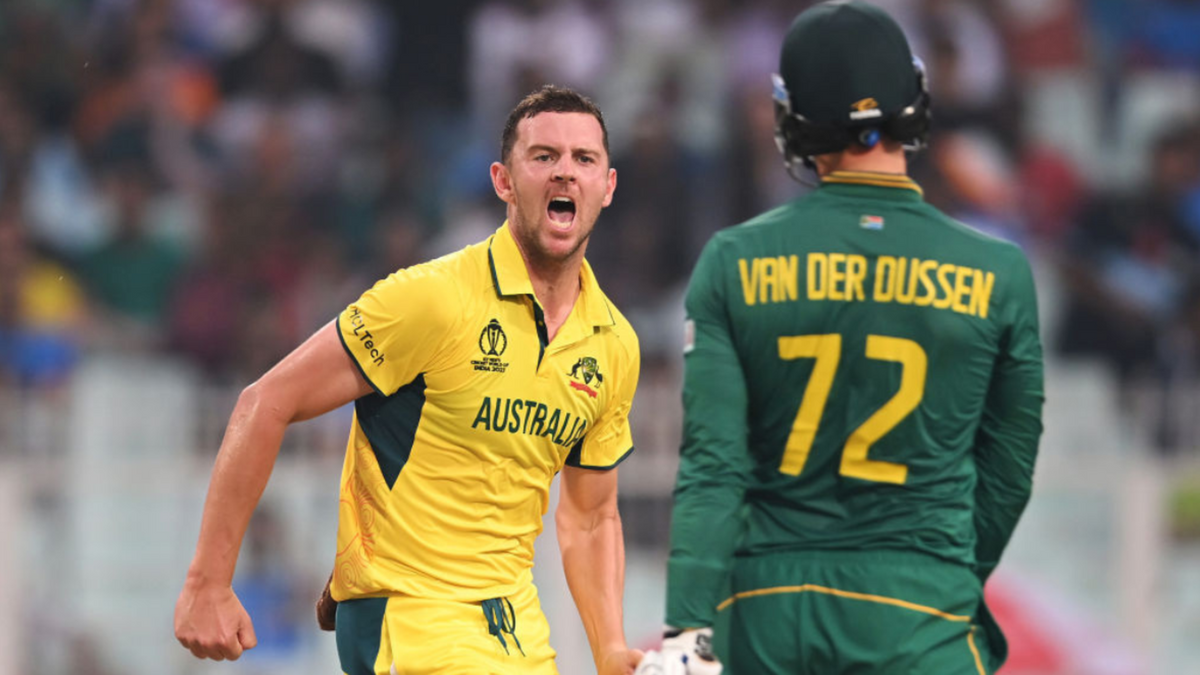
Under overcast skies, Australia were at their authoritative best with the ball and on the field early in their semi-final against South Africa at the Eden Gardens in Kolkata.
To bet on the World Cup with our Match Centre Partners bet365 head here.
At the toss, both Temba Bavuma and Pat Cummins said that they wanted to bat first. The supposedly slow Eden Gardens surface as well as South Africa’s and Australia’s difference in records between batting first and second might have been the common factors behind their thinking, and understandably so.
Out of the four matches played at the Eden Gardens in the 2023 World Cup before the semi-final, three had been won by the team that batted first. The first innings batting average had been 32.23 compared to 20.42 in the second. Runs had come at a rate of 5.61 while batting first, almost a run quicker than that while batting second (4.63).
Granted there was a cloud covering and that rain was on the radar, something both captains alluded to as well at the toss (although only as an afterthought), all things considered, including the pressure of a World Cup semi-final, batting first seem like a sensible decision. Until Australia proved it was not.
Mitchell Starc, who has not had a great World Cup by his standards, having picked only ten wickets in the league stages from eight games, started with his natural length, right up to the batter, but wasn’t in complete control of his line in the first over.
A leg stump half volley was flicked by Quinton de Kock for what could have been the first boundary of South Africa’s innings in the second ball of the first over itself, but it met a diving Travis Head at square leg who restricted it to just a single. Eventually, South Africa’s first boundary came fifty balls later, in the ninth over of the innings.
The change of strike brought Bavuma on strike. He had declared himself “not 100 per cent fit” at the toss and he only lasted only four balls, edging the last ball of the first over behind to the wicketkeeper to hand Australia their first breakthrough.
Josh Hazlewood shared the new ball with Starc. With overhead skies and a spicy pitch on offer, the stage was set for him to do his thing, to bang away on a good length and get the ball to nip both ways. He did exactly that. His first ball beat de Kock’s bat, the second found his outside edge, only to go wide of slip.
Twelve of Hazlewood’s first 15 balls were dots. De Kock, batting on three off 13, had had enough of it. He tried to deposit yet another good length ball on the stumps beyond the sightscreen, but only managed to sky it straight down the ground where Cummins took a tumbling overhead catch.
After six overs, South Africa’s score read 8-2, in stark contrast to India’s score at the same stage in the first semi-final against New Zealand yesterday, 58-0.
South Africa’s agony wasn’t to end there though. Starc, who had not bowled more than four overs in his first spell in this World Cup so far, was given a sixth (and eventually a seventh) today. When Aiden Markram flicked him for his second boundary on the first ball of Starc’s sixth over, it felt that South Africa might just break the shackles. Instead, four balls later, they lost their third wicket.
Starc corrected his line to outside off, inducing a drive from Markram, who got a thick outside edge to backward point. David Warner, who along with his teammates had already made several diving stops inside the thirty-yard circle, flew to his left to send Markram packing.
Hazlewood then got Heinrich Klaasen to edge one in the next over that fell short of slip. Such was his relentless accuracy that he induced another edge on the very next ball, this time off Rassie van der Dussen, and this time it went straight into the lap of Steve Smith at second slip. To cap off what had been a brilliant over, Hazlewood got a third successive outside edge on the last ball, off David Miller, which went past the slips for a four.
By 12 overs, South Africa had managed only 28 runs for the loss of four wickets, with Starc and Hazlewood sharing two each for 14 and 12 runs respectively.
A day after India and New Zealand amassed more than 700 runs in a brazen display of clean, white-ball batting in a World Cup semi-final, Australia had South Africa on the ropes by bowling red-ball lines and lengths and throwing their bodies around on the field.








